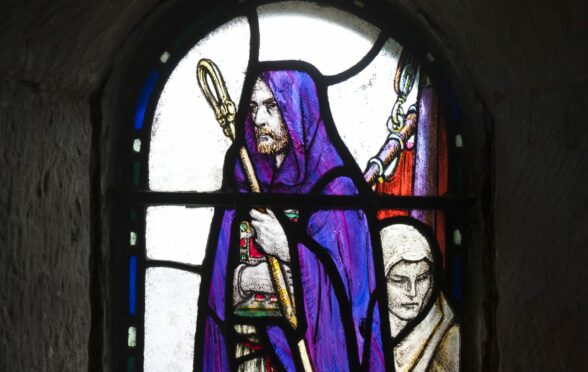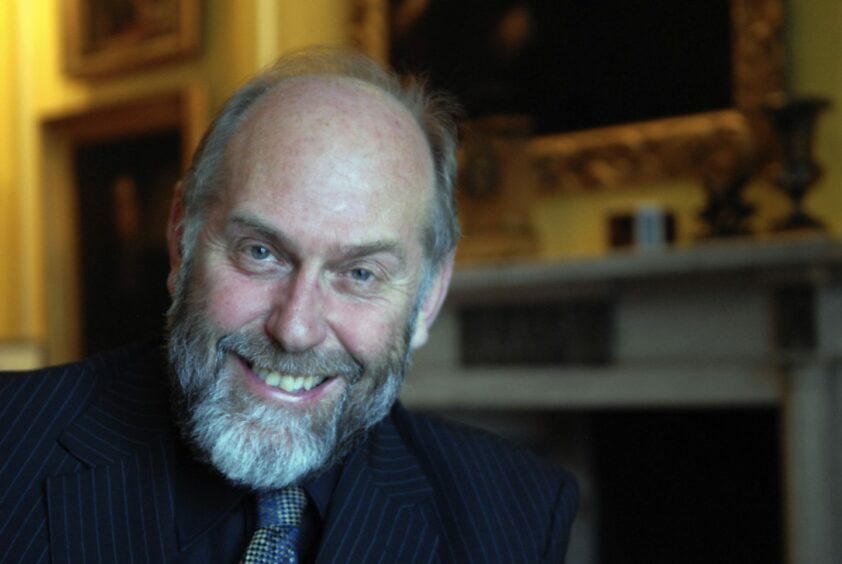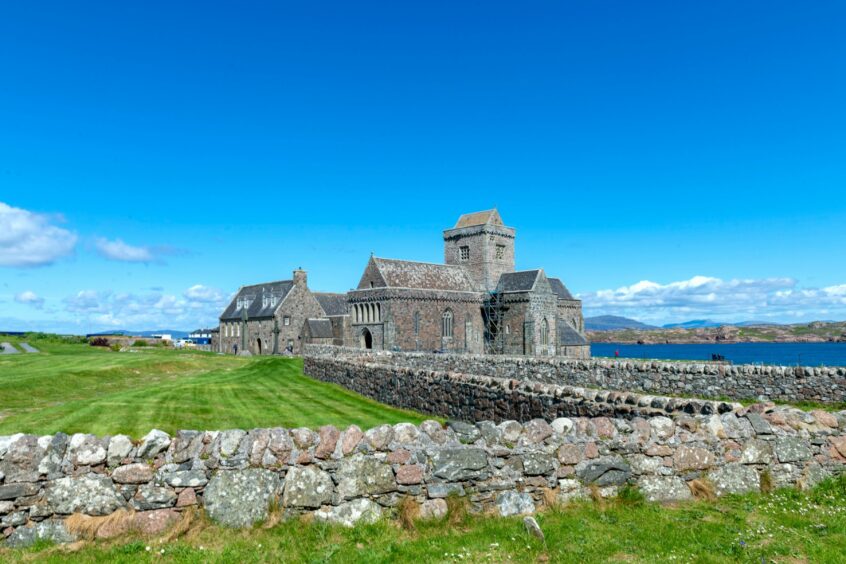
Saint Columba is well known for bringing Christianity to Scotland 14 centuries ago, but he was only one of the pioneers who braved the stormy waters from Ireland to the Hebrides to preach the Word of God.
Historian Alistair Moffat travelled on foot, by boat and ferry to follow the journeys of these forgotten Irish saints and seek out the remote places where they left their spiritual mark to research his new book, Islands Of The Evening: Journeys To The Edge Of The World.
“There is more to the story of the Christian conversion of the west and north of Scotland than Columba,” said Moffat. “But sources for the lives and works of the other holy men who sailed among the islands and sea lochs from the 6th to the 8th Centuries are vanishingly scant. Sometime only the whispers of half-forgotten stories survive.
“I embarked on a series of voyages of discovery that would take me to the remote islands, the places of solitude they so eagerly sought.”
His journey took Moffat from the barren, sea-washed rocks of the Garvellachs and the “great garden” of Lismore to the haunting calm of Iona and the rugged grandeur of Applecross.
Moffat has great admiration for the holy men who converted Scotland to Christianity, despite not being a man of faith.
“I’m interested in sanctity. I’m not a Christian but I do believe that our society owes a great deal to the legacy of these leathery old saints and what they believed in: the idea of giving your life to God.”
Moffat set out to discover saints, just as important in their time as Columba, who also ventured into unexplored heathen lands from Ireland.
“From the fifth and sixth Centuries onwards, there was a great deal of communication between Ireland and Hebridean Scotland. People and ideas flowed up and down the Atlantic shore,” added Moffat.
“Columba, who founded Iona, is well known as his life was documented. St Brendan less so, although The Voyage Of St Brendan was written between 900 and 1000. Brendan the Navigator was one of the very earliest of the holy men to set sail from Ireland to found monasteries in Scotland.”
Moffat travelled to the uninhabited island of Eileach an Naoimh, “the rock of the saints”, on the windward edge of a tiny archipelago known as the Garvellachs, where St Brendan established a community of monks who lived and prayed in dry stone “beehive cells”.
Moffat found himself where Brendan and his monks spent their time praying, fasting themselves into a hallucinatory state, and mortifying their flesh by immersing themselves in the freezing sea to feel nearer to God.
“You wouldn’t want to go there on holiday,” said Moffat. “To the west lie the vast wastes of the ocean with no shelter from any storm. It was the sort of raw, elemental place that attracted these ascetic men.”
The island still has two of the three-metre high by six metres cells Brendan and his men built in the 6th Century, the oldest surviving ecclesiastical buildings in Britain.
“Inside, there was a palpable sense of sanctity. The monastic precinct was like the calm heart of a wild, elemental island set in a turbulent sea that crashed around its shores,” said Moffat.
He next went in search of St Moluag in the fertile island of Lismore, the Great Garden in Gaelic. The saint would have arrived in the 6th Century when the Irish sea lords, known as the Dalriadans, were colonising the southern Hebrides and Kintyre.
“In the wake of the warriors, the word of God also set sail from Ireland, and it was in the territories controlled by their Irish kindred that Brendan, Columba and others began to found monasteries. They also supported and helped to legitimise the Dalriadan kings and evangelised their peoples.”
St Moluag founded a monastery on Lismore in 562, and it was said went on to found 100 more. He was also the patron of the Kings of Lorn, who ruled over Dalriada.
Recent studies conclude that it was Moluag, a noble-born bishop, who led the deputation to the pagan Pictish king Bridei’s fortress near Inverness. They travelled in currachs (small wooden boats across which animal hide was stretched) through the Great Glen, sailing through deep lochs and carrying the small boats to travel overland. Today there are still churches, places, Pictish stones, and fairs all over the north and north-east named after the saint.
“Moluag may have been the earliest patron saint of Scotland, more favoured than Columba or Andrew, and yet he has been almost entirely forgotten.”
Moffat went in search of another forgotten saint, Maelrubha, whose name translates as “the red priest” and who established a monastery in Applecross in the 7th Century. There are more than 40 versions of his name lent to places, including Loch Maree, where a small island is said to have magical healing powers.
“His vital role in the history of the Christian conversion of northern Scotland has been largely ignored, but the landscape remembers Maelrubha. Over a wide swathe of the Highlands and the Moray coastlands, there are 30 dedications to the memory of his great sanctity.”
Iona is the best-known genius loci, or holy place, in Scotland, and Moffat’s journey to the island where Columba set foot in 563 was personal. As an old friend of the late John Smith, a visit to his grave brought back memories of the leader of the Labour Party, who died in 1994. “Iona inspired Columba and his successor, George MacLeod, who founded the Iona Community, and I wanted to understand something of why and how. The spirit of this place must be powerful but how did it work its magic, what made it different, a place apart?”
Moffat spent the night in the open air on the machair, listening to the waves. “I felt myself in the midst of the world’s clock, moved not by the action of a mechanism but by the four elements. The earth beneath me was cooling, the air around me clean and fresh, the waters of the ocean beating the shore like a drum, the fire of the sun dying beyond the horizon. This was old time, eternal time, the turns of the weather, the seasons and the moods of the land.
“MacLeod reckoned Iona to be a thin place and I began to intuit what he meant. The veil between worlds, between the spiritual and temporal, between what can be seen and what can be imagined, was gossamer thin for me on that evening. Although I am sure there is no God, I came to understand there are places that are touched by an otherness, that have a unique spiritual atmosphere that seems to have no empirical explanation,” he said.
“The lives of those men who searched the skies for angels have long faded, their monasteries have been long lost and reclaimed by the grass and the heather, their stories destroyed or forgotten, their names barely remembered, but the influence of the old saints of the west has not yet fled.”
From the book: ‘I set the candles close to each other and watch the flames’
Alistair Moffat’s journey around the Hebrides and Atlantic coast took him to Iona, where he had a moving and personal experience in St Oran’s Chapel after visiting the grave of his friend, John Smith, in the Reilig Odhrain.
Very simple and with a sanctity needing no adornment, the little chapel was deserted when I entered, lit only by a few votive candles.
Since the death of my first granddaughter, Hannah Moffat, in 2015, and the birth of Grace, her little sister, in 2016, I have sometimes lit candles for them, my wee lasses. So that Hannah’s memory and Grace’s hope burn bright, especially in the peace of ancient churches, I set them close to each other and watch the flames flicker, anxious a sudden draught does not blow them out. In places where generations of mourners have wept for loss, my tears were for the future that was taken from the child we were never allowed to know. It does not matter to me, someone who does not believe in God, that I light candles in a church. I expect no comfort from anywhere and, in any case, where else could I do such a thing? What matters is the peace, the quiet and the dignity. This deserted little chapel seemed to me to have those things and perhaps I could believe a little in the notion of holy ground or at least holy places. There is no sin to wash away, no need for faith in cleansing soil, only grief that will never mend. But, in St Oran’s, my tears were for my girls, not for me. I have had my life and I hope that Grace will have hers, but, for Hannah, there will be nothing except remembrance.
Islands Of The Evening by Alistair Moffat is published by Birlinn

Enjoy the convenience of having The Sunday Post delivered as a digital ePaper straight to your smartphone, tablet or computer.
Subscribe for only £5.49 a month and enjoy all the benefits of the printed paper as a digital replica.
Subscribe
